Chrysanthemum Tea with Goji Berry: A Soothing Herbal Classic with Surprising Benefits
Healing Sips from Grandma’s Garden
I first tasted chrysanthemum tea with goji berry on a cool spring afternoon in my grandma Mabel’s kitchen. She handed me a steamy mug filled with golden petals and ruby-red berries, whispering, “Good for the eyes, better for the soul.” Back then, I didn’t fully grasp the magic she had steeped into that cup, but now—living in the heart of Asheville with herbs lining my kitchen windows—I see it clearly.
Grandma never measured. She just knew. Her hands moved from the linen herb sacks to the bubbling kettle like it was second nature. She’d dry wild chrysanthemums by the woodstove and add a small scoop of goji berries she ordered once a year from the Chinese grocer in Louisville. I remember how floral the air would become—delicate and earthy, like rain over marigolds. And if one of us kids had dry eyes from the wind or caught a spring fever, that was the tea she brewed.
Now I make this same chrysanthemum tea with goji berry for my own friends and family. It’s gentle but strong, just like Mabel. And in my herbal practice here in Asheville, I’ve come to appreciate how this tea doesn’t just soothe your system—it connects you to something older, something tender and deeply nourishing.
You’ll still find jars of dried chrysanthemum flowers beside elderberry syrup on my shelves. And goji berries? Always soaked overnight, just like she taught me. They’re not just for color—they carry a long tradition of restoring balance and lifting fatigue. This tea isn’t trendy in my home; it’s sacred.
If you’re curious about other teas I sip when feeling run-down, take a peek at my drinks page. And if you swing by, I’ll pour you a cup from my kettle that still smells like history.
Rediscovering Herbal Wisdom in Asheville
These days, when people ask me what chrysanthemum tea with goji berry is good for, I smile and say, “Everything your nervous system and liver have been craving.” This blend isn’t just a folk remedy—it’s backed by herbal tradition and modern wellness science alike. From reducing eye strain (hello, screen time!) to cooling the body and gently nourishing blood circulation, this tea has earned its place on my daily rotation.
But what I love most? It’s so simple. Two ingredients—steeped with intention—create something far greater than the sum of its parts. That’s the kind of healing we all deserve.
Nourishing Benefits of Chrysanthemum Tea with Goji Berry
What is Chrysanthemum and Goji Berry Tea Good For?
Chrysanthemum tea with goji berry is a soothing, healing drink that blends floral calm with nourishing sweetness. Traditionally used in Chinese medicine, this tea has been known for centuries to support the liver, improve eye health, and gently cool the body from the inside out. If you’ve been feeling overheated, stressed, or fatigued, a warm cup of chrysanthemum tea with goji berry may be just what your body needs.
The chrysanthemum flowers help reduce inflammation and are particularly valued for relieving eye strain—perfect for folks who stare at screens all day. Goji berries, meanwhile, bring a naturally sweet flavor while supporting blood circulation, skin hydration, and immune function. Together, they form a powerful combination that restores energy without overstimulating your system.
People often ask what chrysanthemum tea with goji berry is good for. The answer? It’s a wellness multitasker. It supports detoxification, calms the nerves, and helps your body gently rebalance. This makes it ideal for daily sipping—especially during allergy seasons or after long hours of work.
What Does Goji Berry Tea Do for Your Body?
When you sip chrysanthemum tea with goji berry, you’re giving your body a rich source of antioxidants, beta-carotene, and vitamin A. Goji berries are prized for nourishing yin energy and gently boosting stamina without adding any caffeine to your day. They also help hydrate the body at a cellular level—making this tea not just calming, but also replenishing.
Goji berries are believed to support better sleep, clearer skin, and sharper vision. Their antioxidant profile helps protect against oxidative stress, making this tea a beautiful choice for anyone focused on long-term wellness. Add chrysanthemum into the mix, and the result is a deeply balancing tonic that’s as functional as it is flavorful.
Drinking chrysanthemum tea with goji berry regularly may also improve circulation, reduce tension headaches, and bring gentle clarity during foggy afternoons. It’s a grounding ritual in a fast-paced world.
Drinking chrysanthemum tea with goji berry regularly may also improve circulation, reduce tension headaches, and bring gentle clarity during foggy afternoons. It’s a grounding ritual in a fast-paced world.
To elevate your experience, take a sip of something powerful like my ginger tea for nausea—another floral-forward remedy with real results.
How to Make Chrysanthemum Tea with Goji Berries at Home
A Simple Guide to Brewing the Perfect Cup
Making chrysanthemum tea with goji berry at home is easier than you might expect. With just two ingredients and a bit of care, you can create a fragrant, golden-hued tea that’s both beautiful and nourishing. Here’s how I make it just like my grandma Mabel taught me—slow, thoughtful, and full of intention.
You’ll need:
- 1 tablespoon dried chrysanthemum flowers
- 1 tablespoon dried goji berries
- 2 cups hot (not boiling) water—around 185°F (85°C)
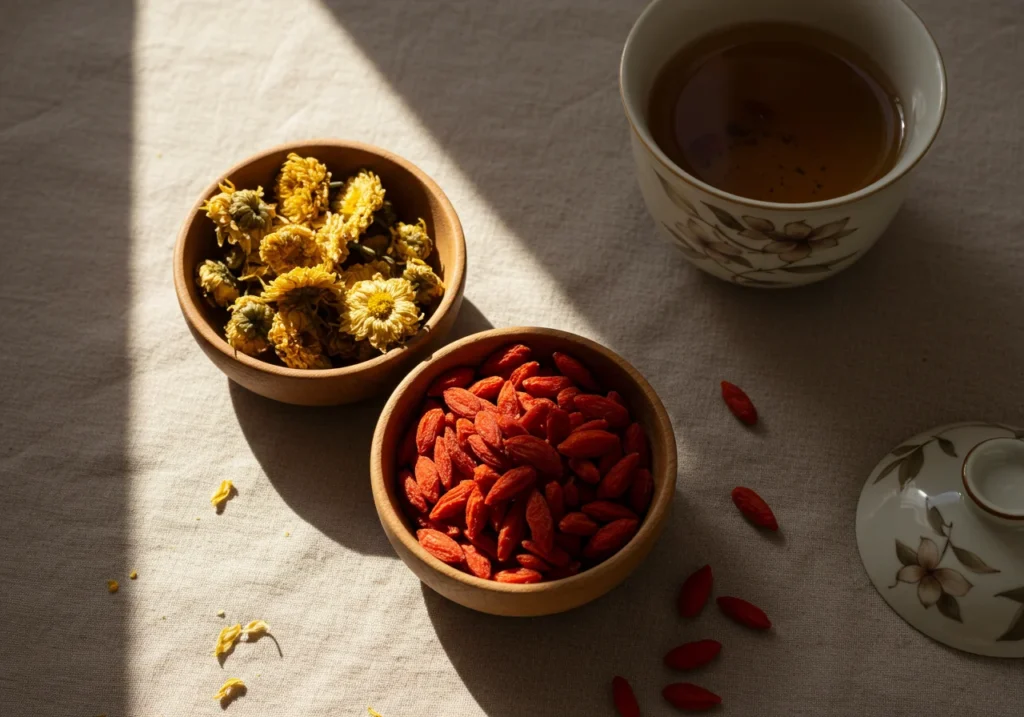
Place the chrysanthemum flowers and goji berries in a heatproof teapot or large mug. Pour the hot water over the herbs and let them steep for 5 to 7 minutes. If you prefer a slightly stronger brew, allow up to 10 minutes. The tea should be golden and gently floral with a hint of berry sweetness.
Strain into a cup or drink it directly if you don’t mind the petals and berries swirling around. Some people eat the rehydrated goji berries afterward—they’re juicy and packed with flavor.
If you enjoy a touch of sweetness, try adding raw honey or a slice of dried licorice root. Just avoid adding sugar, as it can overwhelm the subtle herbal notes of chrysanthemum tea with goji berry.
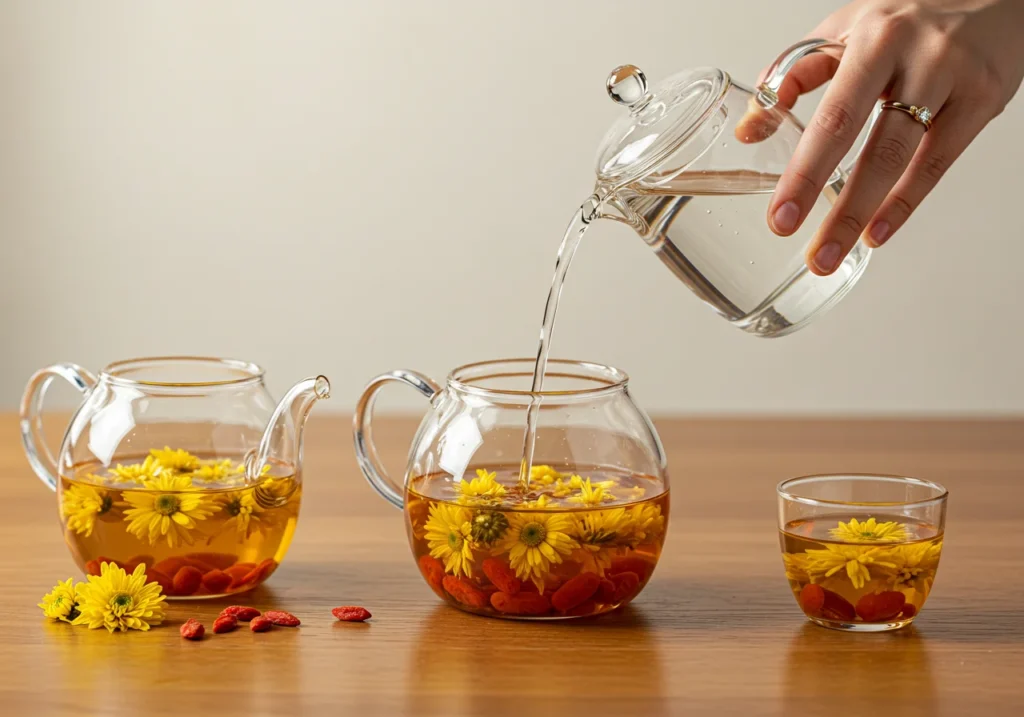
Tips for Balancing Flavor and Function
One of the joys of chrysanthemum tea with goji berry is how adaptable it is. If you’re dealing with a sore throat or early signs of a cold, consider adding a sliver of fresh ginger or a few crushed jujube dates to warm the blend. Feeling too warm or dealing with inflammation? Keep it simple with just flowers and berries for a cooling effect.
Want a richer mouthfeel? Add a few extra goji berries and steep slightly longer to release their fruitiness. Looking for something even more soothing? A pinch of dried mint or lemon balm pairs wonderfully with this floral base.
Store any leftover tea in the fridge for up to 24 hours, and enjoy it iced the next day. It makes a refreshing midday tonic, especially in warmer months.
In my Asheville kitchen, I always have jars of chrysanthemum tea with goji berry ready to go. It’s one of the easiest ways to reconnect with herbal rhythms—and with yourself.
Store any leftover tea in the fridge for up to 24 hours, and enjoy it iced the next day. It makes a refreshing midday tonic, especially in warmer months.
In my Asheville kitchen, I always have jars of chrysanthemum tea with goji berry ready to go. It’s one of the easiest ways to reconnect with herbal rhythms—and with yourself. If hydration is your goal, pair it with my chia seed water for a complete wellness boost.
When to Avoid Chrysanthemum Tea with Goji Berry
Precautions and Herbal Considerations
While chrysanthemum tea with goji berry is generally safe for most people, there are a few situations when you might want to pause before brewing that next cup. Like all herbal remedies, it’s important to know your body—and to understand that even gentle plants can have strong effects under certain conditions.
If you’re allergic to flowers in the daisy family (like ragweed or marigolds), you may also react to chrysanthemum. Symptoms could include skin irritation, digestive upset, or even mild respiratory issues. In that case, it’s best to skip the tea and explore gentler alternatives like mint or rooibos.
Pregnant or breastfeeding individuals should consult an herbalist or health provider before consuming chrysanthemum tea with goji berry. Though goji berries are nutrient-rich, their effects on hormone balance and circulation may not be appropriate during pregnancy. Chrysanthemum also has cooling properties that might not be ideal for those already prone to cold or depleted energy.
If you’re currently taking medications for blood pressure, diabetes, or anticoagulants, always ask your provider first. Both goji berries and chrysanthemums can interact with certain drugs.
How to Enjoy It Safely and Mindfully
The best way to enjoy chrysanthemum tea with goji berry is to listen to your body. If the tea makes you feel too cold, add warming ingredients like ginger or drink it alongside food. If you feel balanced and uplifted afterward, you’re on the right track.
This tea is ideal during the early afternoon or after dinner—especially during the spring or fall when your body craves both clarity and calm. It’s not recommended first thing in the morning on an empty stomach, as the cooling nature of chrysanthemum can sometimes dull digestion temporarily.
Avoid oversteeping or overusing this tea if you’re feeling weak, pale, or constantly chilly. In those cases, warming teas like ginger-cinnamon or astragalus root may be a better fit.
Timing your herbal sips is just as important as what you sip. My tea timing guide helps you match your daily rhythm with the right infusions for every mood and need.
What is chrysanthemum and goji berry tea good for?
Chrysanthemum and goji berry tea is known to support eye health, liver function, and immunity. It helps reduce inflammation, ease stress, and cool the body, making it ideal for modern stress and screen fatigue.
What does goji berry tea do for your body?
Goji berry tea provides antioxidants, supports healthy skin, boosts circulation, and improves sleep. It nourishes the blood and enhances energy without caffeine, offering a daily tonic for vitality.
How to make chrysanthemum tea with goji berries?
Steep 1 tbsp dried chrysanthemum flowers and 1 tbsp goji berries in 2 cups hot water (185°F) for 5–7 minutes. Sweeten with honey if desired. Strain and enjoy warm or iced.
When should you not drink chrysanthemum tea?
Avoid chrysanthemum tea if you’re allergic to daisies, are pregnant, breastfeeding, or take medications for blood pressure or diabetes. Those with cold constitutions should consume it cautiously.
A Daily Ritual Rooted in Calmness
In the quiet hum of my Asheville kitchen, a warm cup of chrysanthemum tea with goji berry still feels like home. It’s more than just a floral brew—it’s a gentle ritual of care, a reminder to slow down, and a gift we can offer our bodies daily. Whether you’re seeking to ease tension, nourish your eyes after screen time, or simply enjoy a peaceful moment, this tea brings comfort in every sip.
If you’re just beginning your journey into herbal healing or you’re a longtime tea lover, I invite you to keep exploring. There’s always something to learn, to taste, to brew. And if you ever want to swap remedies, share your stories, or see what’s simmering on my stove today—join me over on my Facebook page where the teapot’s always on.
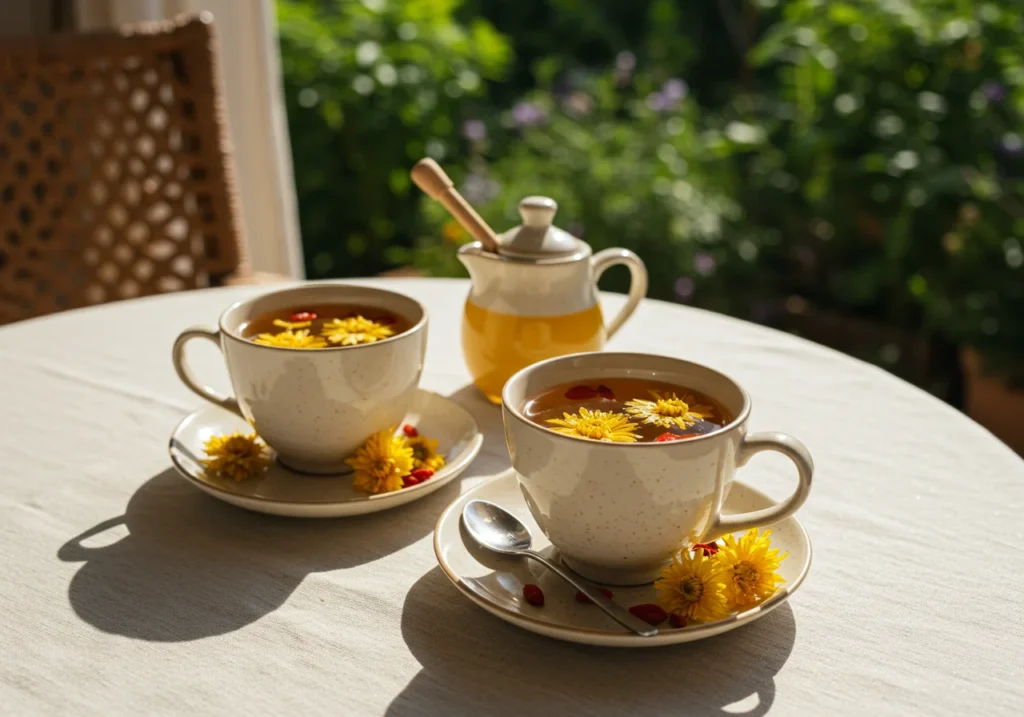
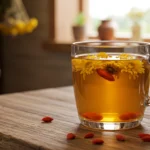
Chrysanthemum Tea with Goji Berry: A Soothing Herbal Classic with Surprising Benefits
- Prep Time: 2 minutes
- Cook Time: 5 minutes
- Total Time: 7 minutes
- Yield: 2 cups 1x
- Category: Herbal Tea
- Method: Steeping
- Cuisine: Asian
- Diet: Vegan
Description
A soothing floral tonic made with dried chrysanthemum flowers and goji berries—great for eye health, immunity, and calming the body.
Ingredients
1 tbsp dried chrysanthemum flowers
1 tbsp dried goji berries
2 cups hot water (about 185°F)
Raw honey (optional)
Instructions
1. Place chrysanthemum flowers and goji berries in a teapot or large mug.
2. Pour hot water (185°F) over the herbs.
3. Let steep for 5–7 minutes.
4. Strain into a teacup and sweeten with honey if desired.
5. Serve warm or iced.
Notes
Avoid if allergic to daisies, or if pregnant or taking medications.
You can eat the rehydrated goji berries after steeping—they’re packed with flavor.
Store leftover tea in the fridge for up to 24 hours.
Nutrition
- Serving Size: 1 cup
- Calories: 18
- Sugar: 2g
- Sodium: 2mg
- Fat: 0g
- Saturated Fat: 0g
- Unsaturated Fat: 0g
- Trans Fat: 0g
- Carbohydrates: 4g
- Fiber: 1g
- Protein: 0.5g
- Cholesterol: 0mg
Keywords: chrysanthemum tea with goji berry, herbal tea, goji berry tea, floral tea
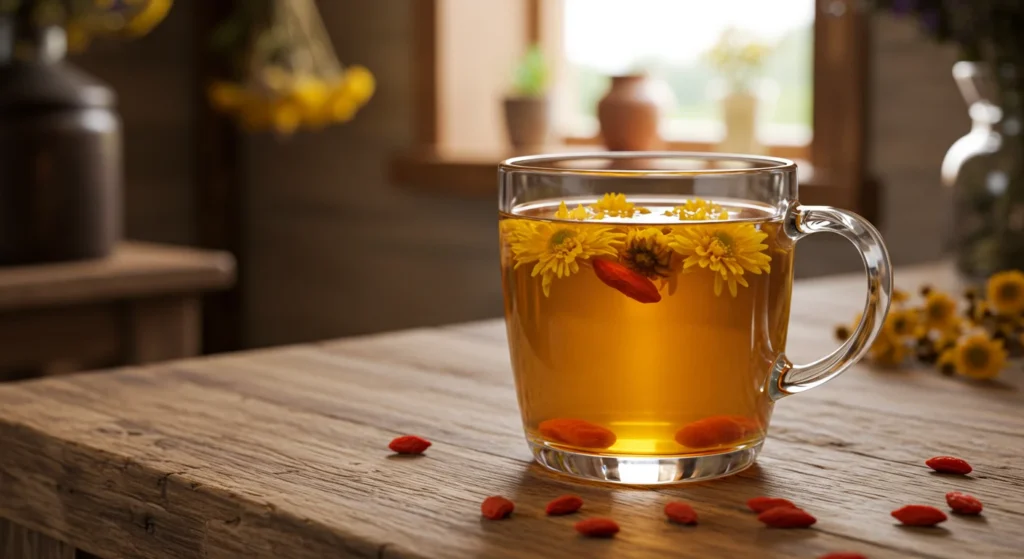
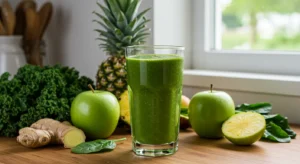

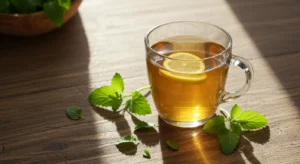
11 thoughts on “Chrysanthemum Tea with Goji Berry: A Soothing Herbal Classic with Surprising Benefits”